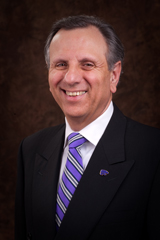February 17, 2015
A letter from V.P. for student life Pat Bosco

Over the last several years, our undergraduate student population has changed significantly. The newest members of our K-State family are brighter, more diverse and are experiencing more financial challenges than ever before.
K-State has long been the top choice of Kansas high school seniors. We take this choice — and the choice of all prospective students — very seriously. This fall, we enrolled 400 more Kansas high school seniors than any other school in Kansas. K-State also has become the top choice in the state for African-American and Hispanic students.
We are now celebrating the early achievements of our newest K-State students. This year's freshman class had an average ACT composite score of 24.1 — the highest in our university's history. We enrolled 532 new in-state freshmen with a 29 ACT composite or higher, representing a 56 percent increase from three years ago. It is no surprise this freshman class also averaged a record-breaking first semester GPA of 2.98. Additionally, we had 63 fewer students dismissed or placed on academic warning compared to the previous year. We consider these achievements to be the first step in undergraduate success that leads to graduation.
These successes in recruitment and retention would not have been possible without a team effort, including our outstanding faculty, academic deans, advisers, student life professionals and our donors, whose support resulted in all-time high university gifts.
We continue to offer opportunities for motivated students to find success. Whether a student is eligible for our University Honors Program or needs additional academic support, we offer programs and interventions designed to help students be successful. In the past two years, we have been very intentional about identifying and serving students who may need additional academic support. For some background, the Kansas Board of Regents allows the state's six universities to admit up to 10 percent of their incoming class outside of the qualified admissions standards. This fall, we enrolled 54 students in the exceptional admission category, which is down from 153 students in 2012. At K-State, students who narrowly miss the qualified admissions standards participate in the Plan for Success program designed around an intrusive academic coaching model. The students in the Plan for Success program earned a 2.52 GPA this past semester with a 93 percent retention rate. We believe these students contributed greatly to our freshman class' success.
We closely monitor the factors that affect our students' ability to succeed, especially financial need. Recently, federal, state and institutional support for need-based financial assistance has remained flat or declined, while tuition rates have increased. This trend creates added pressure for students with high financial need, who are characterized by qualifying for Federal Pell Grant assistance. For context, the average annual family income for K-State Pell Grant-eligible students is less than $40,000. Nearly 23 percent of in-state students in the fall 2014 freshman class were designated as high need. A higher percentage of K-State students and families qualify for and are awarded financial assistance than any other student body in Kansas. These facts about our students define us as a school.
We remain concerned that increasing financial pressure will negatively affect our students and their ability to succeed. Students with high financial need report greater feelings of stress, are more likely to leave the university or choose not to attend K-State from the beginning.
We plan to continue our successful efforts in raising merit-based scholarships, offering timely help through the Office of Student Financial Assistance and financial literacy counseling via our Powercat Financial Counseling Center. We also will significantly increase our efforts in securing need-based forms of student financial assistance to help high-need students who have the capacity for success.
I have heard some concern about the future of enrollment at K-State — how can we maintain a high-quality incoming class, increase diversity and provide an environment that supports student success? The Kansas Legislature and Board of Regents have established new admissions criteria and processes for this fall. As a result, our incoming students will probably be more academically prepared, and our class will likely be smaller and unfortunately, less diverse. First-generation students, which represent nearly 40 percent of our student body, and those whose high schools to do not fully promote postsecondary options are not getting the word about these changes in a timely manner. To disseminate this information, we have significantly increased all contact with our prospective students, now reaching more than 500,000 targeted communications in the current recruitment cycle. We also have increased contact with educators from across the state and in key out-of-state-markets. As we consider the K-State 2025 plans for strategic enrollment growth for the university, we know that we all have a stake in this discussion and we all have the opportunity to help the university meet its goals.
We have prepared information to provide a snapshot of this year's freshman class. In another letter, I and others might address transfer, international and graduate enrollments. We hope that this will be helpful in our discussions about the success and future challenges of our students.
As challenges arise, it is reassuring to know that the K-State family as a whole is committed to student success. I am grateful for all you do.
Thank you,
Pat J. Bosco, Ph.D.
Vice President for Student Life and Dean of Students
